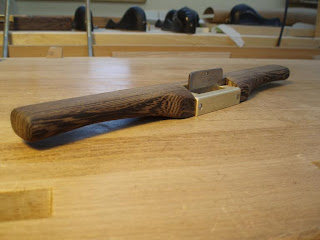
Upon arrival home there were a couple of packages waiting for me. One which I have been eagerly awaiting is this! A plane made by JK himself! I believe it is of Kingwood, an 1 1/2" smoother which despite it's rough looks is quite comfortable. I'm glade that I got a chance to get one of his planes. It will be with me for a long time as a tool and a source of inspiration. On a sad note this and one other plane that I know of are the last to come from his shop. A week or so after completing the planes he cleared out his shop I believe to use as a studio for him and Britta. I'm sure a number of us hope for more writings from Mr. Krenov.

This lovely little "package" was not waiting for me but sent in transit while I was still on the road home. The Davis and Wells DBM-64 boring machine pictured sitting on the dock of my good friend's place of business. It is a later model though I haven't looked for what year specifically yet. I'm not sure that they ever came with single phase motors but this one has a running one! It looks in pretty good condition though the original paint had been replaced. I was amazed at how easily the nuts and bolts came of in dismantling it in pieces to fit in my little car. Hopefully this along with the motor are signs of good and somewhat recent care.

I ran off and picked out some lumber to turn my make-shift work bench into a proper one. Ash for the base and maple for the top additions (as the top is already maple).

As I was trying to do a 1/2 scale drawing of the bench I ran into one major question mark... How long is the tail vise to be? It's kind of a major factor as it (for me) determines the position of the leg, and in turn gives rise to an acceptable base length. I wanted to just start with the base but now I'm trying to get the vise core out of the way.
As I had mentioned there is a lot more work to do to get things going. I spent a day or two trying to clean out the room that will be my bench room, along with other areas to allow for storage. I was doing some fitting with the core and needed to sharpen my blade... woop, no sharpening station. I had gotten and old hand bench grinder off ebay but it takes a 5" or so wheel... what do I do? get a different grinder or try to take a 1/2" of the radius off a 6" one... wait I have no diamond wheel dresser... and so on.
Also getting used to a different batch of machinery. Each machine has it's own "personality" if you will and it is important to learn them to use your machines accurately and efficiently. The disadvantage is that for the last 3 years I had been working with pretty top-notch machines and the ones here are smaller and of lesser quality. That may be so and may be a bit frustrating but I do have machines to use and use them I will to the best of my ability.
On that note I should get to work!













